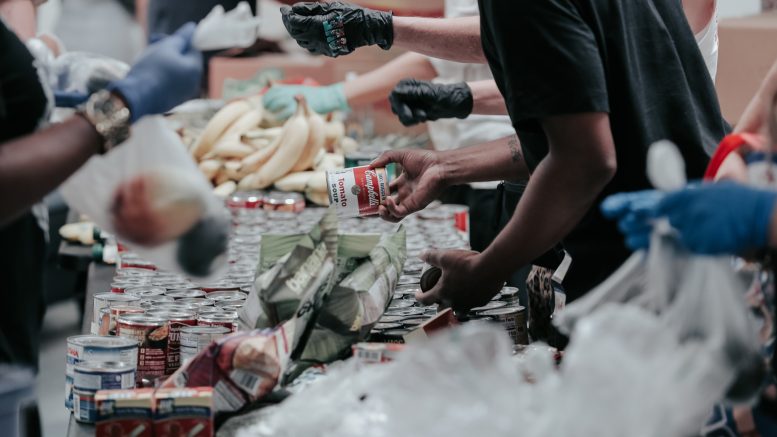By Jenna Kuang for CalMatters
Food banks across California are bracing for a feared spike in hunger amid inflated prices after a pandemic-era boost in food aid ends in April.
March is the last month CalFresh recipients will get the additional benefits, as the federal government cuts off the “emergency allotments” that have kept food stamp allowances higher than usual for nearly three years now.
The average household on CalFresh will lose about $200 a month, said Becky Silva, government relations director at the California Association of Food Banks. A single-person household, for instance, could drop from $281 a month in food aid to as low as $23 in April.
U.S. Department of Agriculture documents show that since November, the pandemic boosts have amounted to more than $500 million a month in additional food stamps coming into low-income Californians’ budgets.
“There’s no way to overstate how devastating this is going to be,” Silva said. “Families are going to see a dramatic and sudden drop in their food benefits at a time when food price inflation and the cost of living in California especially is through the roof.”
Food stamps are funded by the federal government, which determines benefit amounts annually based on the nationwide cost of living as well as recipients’ household size and income.
In March 2020, Congress allowed the USDA to give states funding to boost all recipients’ aid to the maximum allowable benefits for their household size, or add $95 on top for those already receiving the maximum. The recent Congressional spending bill passed in December cuts that off this spring in exchange for funding for extra food aid for school children during the summer months.
More than 2.9 million California households receive food assistance through CalFresh, a number that has risen steadily throughout the pandemic.
The state social services department attributes the increase partially to a more flexible application process during the pandemic, while advocates like Silva also suggest the boost in aid made going through an application more worthwhile for eligible residents.
The loss of emergency allotments will be felt particularly hard by older and disabled people, many of whom have already seen their food aid eligibility reduced after a historic inflationary bump in Social Security checks in January. In addition to wages, Social Security, unemployment benefits and disability payments all count as income for the person receiving food aid.
Tom McSpedden, a 69-year-old Citrus Heights resident with Type II diabetes, saw a nearly $60 decrease in his normal CalFresh allowance last month after getting a $109 increase in his monthly Social Security checks.
But he continued to get the pandemic CalFresh boosts, which kept the total food stamps on his benefits card at $281 that month – the maximum allowable aid for a single-person household.
In April, McSpedden’s monthly CalFresh benefits will drop to roughly $50.
Nearly half of McSpedden’s monthly $1,368 Social Security check goes toward renting a room; the rest is meticulously budgeted for his phone, car insurance, gas, the portion of insulin and medications that Medicare doesn’t cover and bankruptcy payments.
“I don’t have the $230 left over each month to compensate” for the drop in aid, he said. “I’m just not going to be able to afford food. It’s that simple.”
There isn’t any plan to immediately backfill the loss.
The food banks association and other anti-poverty organizations have proposed that the state spend more than $2 billion providing a “ramp-down” of the extra benefits for five months after the federal boosts end.
But it’s unclear whether the Legislature and Gov. Gavin Newsom’s administration would agree on new spending as they seek to close a $23 billion budget deficit.
Advocates are also calling for the state to add its own funds to the regular food stamps program, to boost the minimum food aid grant from $23 to $50 with corresponding inflationary increases. Other ideas include expanding special CalFresh programs that provide extra dollars for those purchasing California-grown produce, or for certain Central Valley households who lack clean drinking water in their homes.
Those proposals are “nowhere near approaching the $500 million a month that will be absent from people’s budgets, dinner tables and California retailers as well,” said Jared Call, senior advocate at the food policy organization Nourish California. “But our approach is, no tool in the toolbox should be unused.”
The California Department of Social Services says it’s warning households of the upcoming decline in aid and directing CalFresh recipients to food banks, which have received additional funding from both the state and federal governments in recent years.
The state’s network of food banks continues to serve on average 1.5 times the number of clients as before the pandemic, Silva said.
The Sacramento Food Bank and Family Services, which provides food in the county McSpedden lives, averaged 150,000 clients a month before the pandemic, said community resource manager Lorena Carranza. In recent months, that number has been about 275,000.
But food distributions can’t replace the flexibility of food stamps that many residents rely on.
With a special diet to manage his diabetes, McSpedden said food distribution boxes usually only contain a few items he can eat. He’s loath to take a full box when others could use it, he said.
McSpedden worked for nearly three decades as a long-haul trucker until about 15 years ago, when a series of heart attacks ended that career and landed him in a hospital stay that wiped out his savings and retirement accounts.
“I’ve been in predicaments before,” he said. “But this thing here with the extra food stamps, I have no idea. I’m looking into a tunnel with no light at the other end.”


Be the first to comment on "‘No light at the other end’: Impending loss of pandemic CalFresh boosts could trigger hunger spike"